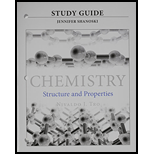
Concept explainers
Interpretation:
Seven lattice and possible variations
| Crystal system | Possible variations | Axial distances or edge lengths | Axial angles | Examples |
| Cubic | Primitive body centred face centred | NaCl, Zinc blende, Cu | ||
| Tetragonal | Primitive Body-centred Face-centred | White tin |
||
| Orthorhombic | Primitive Body-centred Face-centred | Rhombic sulphur |
||
| Hexagonal | primitive | Graphite, |
||
| Rhombohedral | primitive | Calcite |
||
| Monoclinic | Primitive | Monoclinic sulphur |
||
| Triclinic | primitive |
Concept introduction:
Zinc blende structure has
This is of the form of
Coordination number
The general
To determine: the compound that is most likely to crystallize in the zinc blende structure shown in figure
Want to see the full answer?
Check out a sample textbook solution
Chapter 13 Solutions
Study Guide For Chemistry: Structure And Properties
- The vapor pressure of ethanol, C2H5OH, at 50.0 C is 233 mmHg, and its normal boiling point at 1 atm is 78.3 C. Calculate the vapH of ethanol.arrow_forwardA 1.50-g sample of methanol (CH3OH) is placed in an evacuated 1.00-L container at 30 C. (a) Calculate the pressure in the container if all of the methanol is vaporized. (Assume the ideal gas law, PV = nRT.) (b) The vapor pressure of methanol at 30 C is 158 torr. What mass of methanol actually evaporates? Is liquid in equilibrium with vapor in the vessel?arrow_forwardThe following data are the equilibrium vapor pressure of limonene, C10H16, at various temperatures. (Limonene is used as a scent in commercial products.) (a) Plot these data as ln P versus 1/T so that you have a graph resembling the one in Figure 11.13. (b) At what temperature does the liquid have an equilibrium vapor pressure of 250 mm Hg? At what temperature is it 650 mm Hg? (c) What is the normal boiling point of limonene? (d) Calculate the molar enthalpy of vaporization for limonene using the Clausius-Clapeyron equation.arrow_forward
- 8.87 Use the vapor pressure curves illustrated here to answer the questions that follow. (a) What is the vapor pressure of ethanol (C2H5OH) at 60°C? (b) Considering only carbon disulfide (CS2) and ethanol, which has the stranger intermolecular forces in the liquid state? (c) At what temperature does heptane (C7H16) have a vapor pressure of 500 mm Hg? (d) What are the approximate normal boiling pains of each of the three substances? (e) At a pressure of 400 mm Hg and a temperature of 70°C, is each substance a liquid, a gas, or a mixture of liquid and gas?arrow_forward8.48 Why must the vapor pressure of a substance be measured only after dynamic equilibrium is established?arrow_forwardThe vapor pressure of I2(s) at 30C is 0.466 mm Hg. (a) How many milligrams of iodine will sublime into an evacuated 750.0-mL flask? (b) If 3.00 mg of I2 are used, what will the final pressure in the flask be? (c) If 7.85 mg of I2 are used, what will the final pressure in the flask be?arrow_forward
- Equilibrium vapor pressures of benzene, C6H6, at various temperatures are given in the table. (a) What is the normal boiling point of benzene? (b) Plot these data so that you have a graph resembling the one in Figure 11.12. At what temperature does the liquid have an equilibrium vapor pressure of 250 mm Hg? At what temperature is the vapor pressure 650 mm Hg? (c) Calculate the molar enthalpy of vaporization for benzene using the ClausiusClapeyron equation.arrow_forwardSilicon carbide, SiC, is a very hard, high-melting solid. What kind of crystal forces account for these properties?arrow_forward
 Chemistry: Principles and PracticeChemistryISBN:9780534420123Author:Daniel L. Reger, Scott R. Goode, David W. Ball, Edward MercerPublisher:Cengage Learning
Chemistry: Principles and PracticeChemistryISBN:9780534420123Author:Daniel L. Reger, Scott R. Goode, David W. Ball, Edward MercerPublisher:Cengage Learning General Chemistry - Standalone book (MindTap Cour...ChemistryISBN:9781305580343Author:Steven D. Gammon, Ebbing, Darrell Ebbing, Steven D., Darrell; Gammon, Darrell Ebbing; Steven D. Gammon, Darrell D.; Gammon, Ebbing; Steven D. Gammon; DarrellPublisher:Cengage Learning
General Chemistry - Standalone book (MindTap Cour...ChemistryISBN:9781305580343Author:Steven D. Gammon, Ebbing, Darrell Ebbing, Steven D., Darrell; Gammon, Darrell Ebbing; Steven D. Gammon, Darrell D.; Gammon, Ebbing; Steven D. Gammon; DarrellPublisher:Cengage Learning Chemistry for Engineering StudentsChemistryISBN:9781337398909Author:Lawrence S. Brown, Tom HolmePublisher:Cengage Learning
Chemistry for Engineering StudentsChemistryISBN:9781337398909Author:Lawrence S. Brown, Tom HolmePublisher:Cengage Learning Chemistry: Principles and ReactionsChemistryISBN:9781305079373Author:William L. Masterton, Cecile N. HurleyPublisher:Cengage Learning
Chemistry: Principles and ReactionsChemistryISBN:9781305079373Author:William L. Masterton, Cecile N. HurleyPublisher:Cengage Learning Principles of Modern ChemistryChemistryISBN:9781305079113Author:David W. Oxtoby, H. Pat Gillis, Laurie J. ButlerPublisher:Cengage Learning
Principles of Modern ChemistryChemistryISBN:9781305079113Author:David W. Oxtoby, H. Pat Gillis, Laurie J. ButlerPublisher:Cengage Learning Chemistry: An Atoms First ApproachChemistryISBN:9781305079243Author:Steven S. Zumdahl, Susan A. ZumdahlPublisher:Cengage Learning
Chemistry: An Atoms First ApproachChemistryISBN:9781305079243Author:Steven S. Zumdahl, Susan A. ZumdahlPublisher:Cengage Learning





